#Kabardin
Text

Portrait of Kabardian Tovchenova. XIX в.
Портрет кабардинки Товченовой. XIX в.
Photographer A. Engel. (А.Энгель)
#Kabardino-Balkaria#Кабардино-Балкария#Kabardin#Кабардинцы#Adyghe#Адыги#Adyghe culture#Культура Адыги
17 notes
·
View notes
Text

Kabardian women combing wool in the village of Atleskirovsky, 1926
Source: https://pinterest.com/pin/636766834843268800/
#kabardines#folk costume#historical photos#1920s#20th century#caucasus#northwest caucasian#circassians#atleskirovsky
3 notes
·
View notes
Text
But like Czar Peter content to toil in the shipyards of foreign cities
I did not expect to meet Peter the Great in Moby Dick, and even less with this reference, but of course, of the many things to note about the Tsar, this is undoubtedly the most characteristic. But not the only one. And since Melville has given me the opportunity to share one of my obsessions, namely the crazy biography of the greatest (literally and figuratively) Tsar of all the Russias, here is a very long post about the figure, work, life and death of a man with only one dream: Ships.
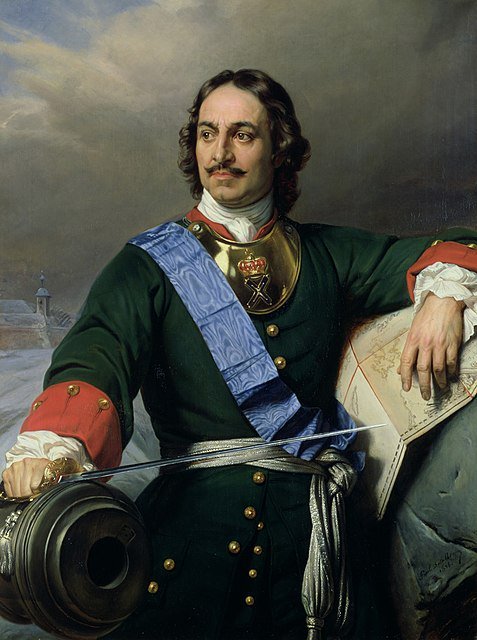
Prince Pyotr Alekseevich was Tsar of Russia, prince of Moscow, Kiev, Vladimir and Novgorod. Tzar of Kazan, Astrakhan and Siberia. Sovereign of Pskov. Grand Prince of Smolensk, Tversk, Yugorsk, Permsky, Vyatsky, Bulgarsky and others. Sovereign and Grand Prince of the lands of Novgorod Nizovsky, Chernigovsky, Ryazan, Rostov, Yaroslavl, Belozersky, Udorsky, Kondiisky and and Sovereign of all northern lands. Of the lands of Iberia (not that one, the other one), of the Kings of Kartlia and Georgia, of the lands of Kabardin, of the Princedoms of Circassia and the mountains and many other states and lands east and west, here and there, and successor and sovereign and ruler.
All this piece of land:
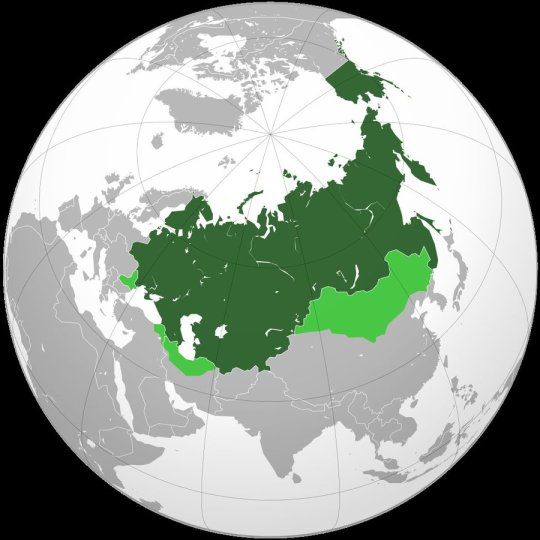
Half of those places have Dragonlance Kingdom names, let's face it.
And it's not easy to govern: seven time zones, fourteen thousand languages, tongues and dialects, myriad cultures, religions and traditions, and the outlet to the sea where God lost his cap. In this beautiful Frankenstein country, Peter was born, the son of Natalia Naryshkina and Alexei I, Tzares of Russia. One of their 13 children, I mean.
The Tzar will be survived by five of his Tzarevichs and at his death he will be succeeded by his son Fyodor III, Peter's elder brother:

Fyodor was 15 years old when he was crowned Tzar of it all.
Educated by the most renowned monk of the time, he spoke Polish and Latin. He was in poor health, half-paralysed and disfigured, but he was a reformer, and began to ventilate the country, which smelled like a bear.
He founded the Academy of Sciences and reformed the law to ease punishments. And he eliminated the "pedigree" system by which public offices were elected in Moscow, the mestnichestvo, unblocking decades of administrative paralysis.
And here is a necessary aside:
The mestnichestvo consisted of civilian and military positions being determined by seniority and family. And that's it. In other words, if you were the fifth son of the Whateverovich family, you could be a third corporal of the Fifth regiment of Irkusk sappers. That's all you need to do, just ask for it and you get it.
Now imagine the entire administration and army of the Duchy of Moscow organised like this. There was a register of all the families and positions so that everything was clear and concise. If anyone dared to sit in your place at the Tzar's table, it came to blows.
The whole administration was full of useless people in high positions because they won the genetic lottery, and capable people eating a turd because they were born in the wrong family, or two months late. It was a real mess.
So Fyodor said enough is enough and ordered the books to be burned. The boyars were not amused by this.
Anyway, good old Fyodor dies and THE PIPHOSTION ensues.
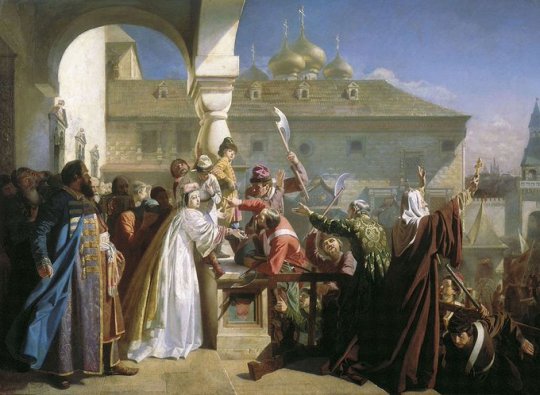
Welcome to the Moscow Uprising of 1682*.
Two sides are fighting for the succession, the Miloslavsky and the Naryshkin. The latter want to appoint Peter Tzar. The former accuse the latter of having murdered Ivan, Peter's half-brother.
Then the Streltsy's arrived.
The Streltsy were a military unit of musketeers with bardiches, who double as police and fire brigade. It's a virtually hereditary post (to no one's surprise) and they lived in their own neighbourhoods in Moscow.
And they were pissed off.
*They order them by date because, as you can imagine, this had more sequels than TRANSFORMERS.

The truth is that the Streltsy are chronically underpaid by the state, which forces them into trade or agriculture. They are also used as border guards in the provinces and as siege troops, which takes them away from their business.
The Moscow Streltsy allies with Ivan's supporters. On 11 May, amid general unrest, they storm the Kremlin and lynch their own officers and several boyars. A few days later they storm the palace and kill several nobles in front of the ten-year-old Peter. It ends with Ivan V as Tzar, Peter as heir and his sister Sophia as regent of all the Russias.
Sophia is, of course, behind the riots.

The infant Tzars "rule" from a double throne. The Tzarevna Sophia sits behind the throne and whispers answers to Peter.
Literally.
She orders to make a little window in the back of the throne.
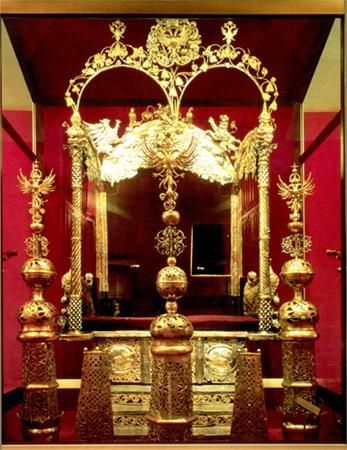
This matters little to Peter: he is the "second" Tzar, he is not going to inherit a shit, and he has an education to take care of, at a time when education was not very interesting.
Except for him.
Peter began his studies with a church accountant named Nikita Zotov. Tzar Fyodor III had already taught the boy his first letters, and recommended his mother to continue with it. Zotov came out of nowhere, was given a flat in Moscow and began to educate.

Zotov freaks out a bit, but he gets on with it. Peter is not a genius, but he is very curious, and when something interests him, it interests him. A lot. They hit it off, the Tsar and the accountant, and Zotov and Peter will be friends for the rest of their lives.
Another of Peter's tutors is Patrick Gordon, a Scottish soldier of fortune who ends up in Russia on the run from the Calvinists. Our wandering Scotsman (and other wandering Scottish chums) go off to the Swedish-Polish war and fight for five years.
On both sides. Several times.
Between him and Paul Menesius, another Scottish soldier of fortune, they educated young Peter in the ways of war. You can see that Russia and Scotland were strangely linked in those years. It is not clear who came up with the idea, but the way to teach young Peter about the things of war was with The Toy Army.
Not "a": THE.
Peter's Toy Army (Poteshnye voiska in Russian) was a unit of 100 sons of the court nobles and diplomats, friends of Peter, along with servants and enlisted personnel more or less by force.
Trained with live ammunition by the Scots.
To learn the art of war, Peter created his war in the Palace courtyard, with artillery, muskets and all the trappings.
The Toy Army was expanded and trained to become the Preobrazhensky and Semenovsky Regiments of the Imperial Guard.
You know that Sci Fi/Fantasy cliché, that breed of invincible warriors raised for WAR from childhood and so on and so forth?
WELL, THAT'S WHAT PETER THE GREAT SET UP: HIS OWN ELITE UNIT OF RUSSIAN SUPER-SOLDIERS.

Peter the Great was the greatest. Of Russia. And of Europe.
No, really.
The Tsar of the Russian Empire was two meters and three centimeters tall, in a century when the average height was around one meter sixty-five.
Summer 1689. Peter is 17 years old, has two regiments of super-soldiers and a mission: to turn Russia into a maritime power. Because someone, we don't know who, has taught young Peter to sail, and he has got the idea into his head.
Peter plans to wrest power from his half-sister Sophia, after she led two disastrous military campaigns in Crimea. Sofia discovers the coup attempt and recruits her Streltsy to stop it. But Peter's loyalists tell him and he flees to the Troitse-Sergiyeva monastery.

Peter entrenches himself in the convent, and his friends come to help him. The boyars also take his side, as do some of the Streltsy. Sophia eventually loses her grip on power, and Peter I takes control of all the Russias.
Because Ivan V is ill.
Since his birth, Ivan V has always been sickly and weak, both in body and mind. He has no interest in government and spends his days in prayer and fasting. He will not be drawn into the coups and counter-coups between his sister and his half-brother.

After his marriage, Ivan gradually disappeared from court life. At the age of 27 he was senile, paralysed and half blind. His death will be the end of the period of the Two Tsars and the beginning of the single rule of Peter I, although since he takes Sophia out of the way Peter is already the Tsar.
Back to Peter.
The first thing he does is to modernise Russia. All of it. The whole thing. From the wardrobe to the army, Peter wants his empire to be a modern nation, like Prussia, England or France, so he reoganises the whole medieval mess he has at home.
With the help of the Scots he overhauls the army and puts it to work as his Imperial Guard. The church is being carved up, he sets up the bishops himself and controls it from the synod. Although he knows the Bible well, it is clear that Peter is not a communicant.
Another thing is the way people dress, which is something he can't cope with.
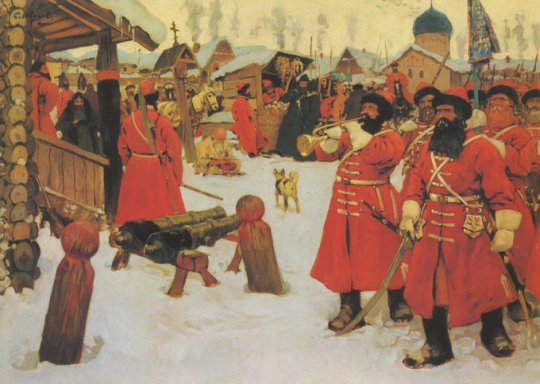
So as a measure to implement the fashion, create a tax on long tunics and beards. Yes, a tax on beards. Every hipster neighbourhood would be up in arms today.
He also set his second great goal: to be a maritime power, because he really liked ships.
At the time, Russia had only two sea outlets: the Pacific, which was a fucking huge distance away from Moscow, and the White Sea, which is only really liquid for like a couple of months of the year.
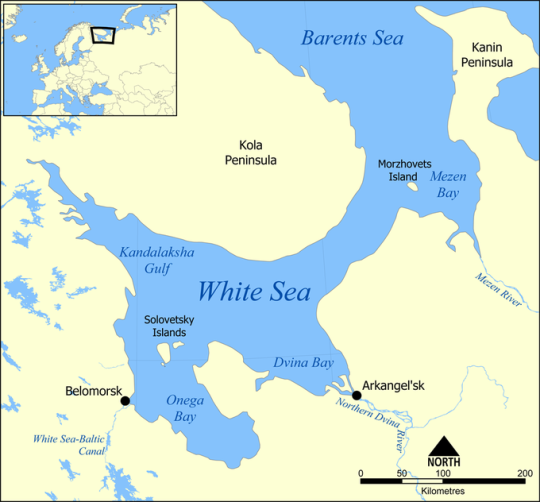
Indeed, Russia is cut off from the North Sea and the Mediterranean. From the former by the Swedes, who are quarrelling with everyone at the time, and from the latter by the Ottomans, who control access to the Black Sea, where Sofia's campaigns to take Crimea have been unsuccessful.
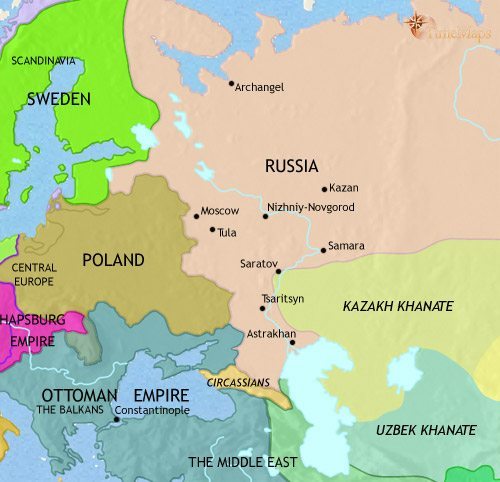
Peter goes FULL WARHAMMER and starts the Azov Campaigns.
Seriously, THE AZOV CAMPAIGNS.
Azov is an Ottoman fortress that stands between Peter and the Black Sea. After making a few arrangements with Poland to pass through, Peter goes overland with two armies for his well-deserved passage to the sea, along with his loyal Scots.
They fail to take Azov.
Although there have been victories, they fail to hold the ground they have gained and must retreat, leaving the fortress back to the Ottomans. But Peter has a plan, and a fixed idea. So he get back to Moscow and builds a fucking fleet and sets off down the river with his new toys: the first Russian Navy Fleet.
And this time Azov falls.
In less than a year, the Russians build and arm a fleet and defeat the Ottomans, taking the fortress than have resisted all previous attempts to be taken.

Bombarded and besieged by sea and land, unable to receive reinforcements and supplies, with the Ottoman fleet on the run, Peter I the Great achieves his first victory and proof that the Russian fleet is more than a passing fancy. Two years after his victory at Azov, the Russian Navy and its first port are created. Although the Ottomans still control Crimea and the Black Sea, the Russian fleet begins to become a reality.
Faced with the Ottoman threat and the need to bring closer ties with the Europeans he so admires, Peter I organises The Grand Embassy, a group of some 300 nobles and diplomats that he sends to Europe to make friends for the Russian Empire. All as part of his master plan…
… to learn how to build more, better ships!
This is where I tell you that the socio-economic conditions in Europe created the need for Peter I's new Russia to open up to the sea, the relations between England and the Danes, etc., but what am I going to fool you?
Peter I wanted ships. Full stop.
So he sends the Grand Embassy to travel around Europe and look for allies against the Ottomans… And to learning about ships.
1697. The 17th century comes to an end. The Grand Embassy travels through Poland and the Germanic principalities, seeking further support for their war against the Ottomans. Their efforts are unsuccessful, but contact will soon bring other unexpected fruits.
The journey west continues.
In late summer the Grand Embassy arrives in Holland. For four months the diplomats meet with other diplomats and nobles. The Ottomans mattered to no one so far from their borders, and in Spain there were more worrying matters: the succession of Charles II.

Heading the embassy is Franz Lefort, a former Swiss soldier of fortune in the service of Tsar Peter I, and one of his closest friends.
Lefort has served with Patrick Gordon in Kiev, and participated in the firsts disastrous Crimean campaigns. Lefort has also done diplomatic work for the Tsars, and during the capture of Azov, he served as admiral of the Russian fleet. The Tsar is a common guest in his household and the social life of the court gravitates around him.

Along with Lefort, Count Fyodor Golovin, another of Tsar Peter's close associates, has been appointed as Count Fyodor Golovin, a boyar with a military career and a world. A lot of world.
During Sophia's regency, Golovin was sent to defend Albazin, by the Amur River:

Defend it from whom?
Well, this man:

This man is the Kangxi Emperor, the fourth of the Quing Dynasty, and one of the most famous and prosperous emperors of the dynasty.
Precisely because he did not allow himself to be pushed around by the Russians, among others.

(Albazin was about where Jixi is now).
Did I forget to mention that this is THE BORDER WITH CHINA?
Yes, where DIO lost his sandal. That's where Golovin was sent with nearly 700 men.
Anyway, not much of a joke: when Golovin arrives in Albazin, the Chinese have destroyed the fort. He rebuilds it, improving the defences, and rallies his men. And the Chinese troops begin a gruelling siege that lasts more than half a year. Of the more than 800 Russians, 66 survive.
The situation was resolved diplomatically, and the Russians leave the banks of the Amur River, the Black Dragon.
Golovin returns to Russia. The real one. At that time, such a journey was the stuff of science fiction, mind you.
This is Golovin, a veteran and friend of the Tsar, who is commissioned by Peter I to hire naval experts and buy modern weapons while he travels around Europe with the Grand Embassy.

Golovin was not only in charge of scouting naval talent: He also brought with him a group of naval engineers, master shipwrights and workers whose mission was to learn the cutting-edge techniques of the shipyards of Europe. One of them was Pyotr Michalov.
Pyotr was apprenticed in the shipyards of the largest fleet of the time, the Dutch East India Company, for four months and five days, and his master certified that he learned all branches of the trade and behaved properly. We know because the documents that certified such learning has been recorded and stored.

But Pyotr Michalov kept a secret… Badly.
He was actually Tsar Peter I!
Peter I. Peter I The Great. THE GREAT.
The two-metre tall Russian, one of the tallest men in Europe, regent of the continent's largest nation, has been working "incognito" in the shipyards for months.
Officially, he is not present at the Grand Embassy. He is still in Russia.

And, officially, the rest of Europe's nobles pretend they know nothing about the two-metre Russian who wants a job in the shipyards and asks a lot of questions and is then accompanied by the authorities to see the new ships.
Nothing at all. No. Niet.
Because Peter likes ships. He LOVES to work the timber and to create the hull and to literally build them. He didn't like to be treated like a nobleman and to be seen like a boss: He want to work with his own hands and to learn the tricks and secrets of the artisans and workers. That's whats Melville talking about when he wrote:
But like Czar Peter content to toil in the shipyards of foreign cities, Queequeg disdained no seeming ignominy, if thereby he might happily gain the power of enlightening his untutored countrymen.
After the Netherlands, the Grand Embassy visited England, where it was clear that all the great powers of the time were more concerned about Spain than Russia. Pedro looks for a comfortable place to spend the winter, but above all close to the Deptford shipyard, where he will once again work "incognito" as a simple worker.
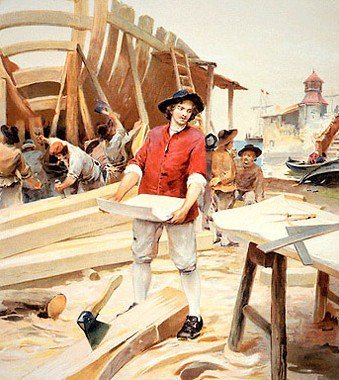
The Grand Embassy is housed at Sayes Court, working in the dockyards and on diplomatic missions, and generally doing Russian: using portraits as shooting targets, destroying gardens with wheelbarrow races, sealing doors and windows with mud…
One of the house servants wrote to his master, John Evelyn (yes, that John Evelyn):
"There is a house full of people and right nasty."
Evelyn claimed damages from the Crown, and had to be compensated almost €40000 in today's currency. It seems he didn't like his guests' habit of using the furniture as firewood.
After the British winter, which is Russian for "pretty nice weather", the Grand Embassy continued on its course through Europe. Since it was clear that the Ottomans were of no importance to anyone, the Russians concentrated on the Swedes, who blocked their access to the Baltic. And here history takes away a unique opportunity. One of those things that make you dream of a uchronia where the world could have been different. Where possibilities are multiplied and juxtaposed in an unrepeatable fractal. One of those almost perfect moments.
Peter & The Embassy are in Poland when the Streltsy Uprising of 1698 breaks out, putting an end to the Grand Embassy and forcing the Tsar to rush back to Russia...
JUST AS THEY WERE ABOUT TO VISIT VENICE!!!!
The Streltsy are fed up. They get paid too little, too late and too badly, and on top of that the Moscow ones have been in Azov for two years. When they are sent to a new posting instead of back to Moscow, they get angry.
A group returns to Moscow to complain, and ask Sophia Alekseyevna, THAT Sophia, for her intercession. 2300 Streltsy head to Moscow with the intention of reinstalling Sofia on the throne. Peter sends 4000 loyal soldiers under Patrick Gordon.
The Streltsy are defeated, captured and cruelly tortured to death, whipped or exiled.

The Streltsy were disbanded in the following years, and Peter I never again toured European countries. The Grand Embassy had taught Peter many things, and it was on his return that the modernisation of Russia began.
With the beard tax.
He also changed the calendar, moving the beginning of the year from September to January, from 7207 to 1700.
After reforming the army by sending home 70% of the officers, and ensuring with treaties that Azov would remain in his power, he turned to Sweden. Peter the Great wasted no time during the Great Embassy. Between building ships and destroying other people's property he still had time for diplomacy. With Poland and Denmark he declared war on Sweden.
The Swedes are doing very well in Europe. The Baltic is theirs, and they have a modern, professional army that allows them to stand up to others who are numerically superior, as Peter is about to find out.
Their king, Charles XII, this steampunk-looking gentleman, will have to deal with Russians and Poles, and although he wins early victories, he will make THE MISTAKE.

The Russians are being cocky at the beginning of the war, conquering to the north-west. The plan is to get an outlet to the Baltic because ships, you know. So they take what will be Estonia, Latvia and Lithuania and keep it. They lay siege to Narva.
Pyotr, who has the attention span of an amphetamine-blind gerbil, leaves a foreign general, De Croÿ, in command of the siege to go somewhere else.
It ends as expected. The Russians are wiped out. The Swedes' tactics disrupt the Tsar's formations and although they outnumber the Swedes 4 to 1, the Russians have neither training, discipline nor morale. The Russian army is slaughtered and surrenders within hours.
But not all.
The Preobrazhensky and Semyonosky Regiments hold their positions and fortify themselves, fighting back while the rest of the Russian troops flee, kill their own foreign officers and surrender to the Swedes.
They are the Toy Army Regiments, and they will not surrender until they are completely surrounded and decimated.

And what is Pyotr doing meanwhile? Founding St. Petersburg, his outlet to the sea and future Imperial Capital:

While Charles XII continues his moves against his other enemies, Russia offers him peace: he now has two seaports, St. Petersburg and Kronstand. Pyotr can now build his fleet and play with his little boats, so he is not interested in war.
But Charles XII will make THE MISTAKE. Rejecting the peace offerings, the Swedes will invade Poland and continue with Ukraine. Their goal: Moscow.
And what always happens when someone tries to invade Russia will happen.
The Russians do not put up a fight, they retreat and burn everything behind them. They wait for winter to catch up with the enemy. At the Battle of Poltava, the Swedes, exhausted and starving, are crushed. Charles XII has to flee south, where he is taken in by the Ottoman Empire during his exile. Russia will win the war and become the modern maritime power that Pyotr always wanted. Charles XII will never forgive himself, and it is not until his death in battle a decade later that peace is signed between Russia and Sweden.
By then, the Swedes had had enough of the Russian navy, which bombarded and attacked the coast year after year, often directly under Peter I's command.
A fleet built from scratch, based in St. Petersburg and Kronstand, in less than five years. Pyotr will continue to reign as Tsar of all the Russias, facing revolts, plots and various wars.
And partying. A lot of partying.
Peter had another passion besides ships. With his friends from the Toy Army, Zotov, Golovin, Lefort, Gordon and others, he would meet at Lefort's house, until the house became too small for him. So much so that Pyotr paid for a palace for 1500 people. Pyotr awarded titles to his buddies, organised sledge races, drinking ceremonies and more parties.
200 colleagues.
Partying.
With the Tsar.
The Grand Embassy was clearly a Russian-style Erasmus.
And finally, the death of our great Pyotr.
Legend has it that Peter was in St Petersburg visiting a shipyard, of course, because Peter the Great was not going to visit a bakery, as we all know… During the visit, Baltic November, Peter saw that some soldiers had fallen into the water and were in danger. Being a naturally courageous person, Peter jumped into the Baltic and there he went, to save his fellow citizens. In November.
And so it was that Peter I the Great, Tsar of All the Russias, etc, etc, died of pneumonia, doing heroic things because he was like that, a very tall man, a very Tsar, who propelled his country 300 years into history, while he lived 600 years ahead of the rest.

I wish Pyotr had discovered zeppelins.
And to bid farewell to this great man, the statue I like the most, without epicness or grandiloquence. The image of a man and his passion:

"Alas! I have civilized my own subjects; I have conquered other nations; yet I have not been able to civilize or to conquer myself."
#Whale Weekly#Moby Dick#Herman Melville#Peter I The Great#European History#Russia#17th Century#18th Century#I don't like the Great Men's History but... He was a GREAT MAN#Also an absolutist monarch#But for the Tsars that come before and after him... Not that bad
49 notes
·
View notes
Text
At the heart of the nation-building process was language. Linguistic criteria were the main proxy for national identity used in drawing up republics’ borders, and where uniform spoken or written forms of the national language were not established, they had to be created. The Soviets employed ethnographers and linguists who had held academic and government posts before the Revolution, and created bodies such as the Commission for the Study of the Tribal Composition of the Population to examine in depth the ethnographic composition of the former empire and make recommendations as to what combinations might constitute national groups, where their borders were to be drawn and what languages they should speak. For the Bashkirs, Kyrgyz, Karakalpaks, Kabardins, Balkars, Chechens, Ingush, Circassians, Karachais and Ossetians, literary traditions were explored in order to find the most suitable forms of written language. Although tsarist-era experts were entrusted with much of the work on language, the most influential figure in the creation and standardisation of local languages was a Marxist, Nikolai Marr, who saw language standardisation for each people as the first step on the road to a hybridisation of languages which would eventually produce the sole common language of the socialist future. Marr also supervised the creation of new alphabets for languages which lacked them, but in the long term he supported the promotion of the Latin alphabet for all languages, rejecting Cyrillic as too closely enmeshed with Russia’s capitalist past. Reformist Muslim intellectuals in the nineteenth century had supported transferring from the Arabic to the Latin alphabet, and Azerbaijan’s new leaders concurred on the basis that it would differentiate Azerbaijan from Turkey and Iran and strengthen ties with Russia, introducing the Latin alphabet from 1924, a move which the other Turkic republics reluctantly followed from 1928.
— Jeremy Smith, Red Nations (2013)
4 notes
·
View notes
Text



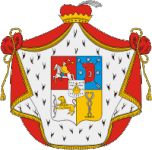
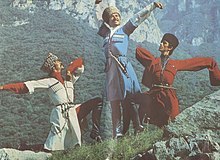


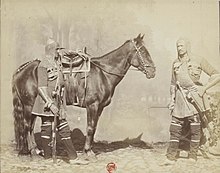








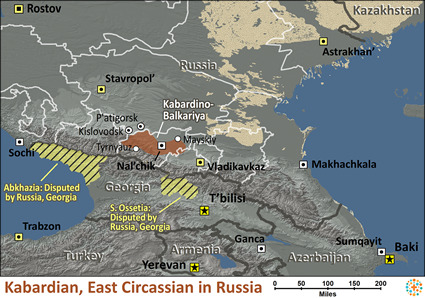
11) Kabardyjczycy (адыгэ, ros. кабардинцы) – mieszkańcy Kabardo-Bałkarii (Rosja) (ok. 400 tys. – lata 90. XX wieku). Język kabardyjski i czerkieski z rodziny kaukaskiej. Od czasów najazdów tureckich wyznają islam sunnicki, z wyjątkiem niewielkiej grupy prawosławnych „Kabardyjczyków mozdokskich”. Historycznie tradycyjnymi zajęciami były uprawa zbóż, pasterstwo. Zachowała się tradycja rozstrzygania spraw na zebraniach starszyzny, przetrwały pozostałości więzi rodowych, w tym krwawej zemsty. Podstawą utrzymania była uprawa zbóż i warzyw, sadownictwo, hodowla, znani zwłaszcza z hodowli koni. Bogaty folklor: pieśni i epos nartyjski (opisujący niezwykłe przygody bohaterów – Nartów), częściowo zbieżny z mitologią grecką – np. bohater Sosruko (kab. Сосрукъуэ), który wykradł ogień i dał go ludziom (por. Prometeusz). Nazwa własna Czerkiesów i Kabardyjczyków to Adygowie (kab. адыгэ, adyge). W XIX wieku ich populacja została zdziesiątkowana w wyniku ludobójstwa dokonanego przez Rosję.
Kabardyjczycy (Adyghe góralscy: Къэбэрдей адыгэхэр; Adyghe nizinni: Къэбэртай адыгэхэр; ros. Кабардинцы) lub Kabardyńczycy - jedno z dwunastu głównych plemion czerkieskich, reprezentujące jedno z dwanaście gwiazd na zielono-złotej fladze czerkieskiej. Są one również powszechnie znane pod liczbami mnogimi Kabardin, Kebertei lub Kabarday. Wraz z plemieniem Besleney posługują się charakterystycznym dialektem języka adygejskiego. Historycznie rzecz biorąc, Kabardyjczycy mieszkali w Kabardii, regionie północnego Kaukazu. W czasach nowożytnych Kabardyjczycy żyją głównie na terenie rosyjskiej republiki Kabardyno-Bałkarii, która częściowo odpowiada regionowi historycznemu. Pomimo sowieckich podziałów administracyjnych, które umieszczały Czerkiesów w czterech różnych określeniach i jednostkach politycznych, a mianowicie Adygejczyków (Adyghe w Adygei), Czerkiesów (Adyghe w Karaczajo-Czerkiesji), Kabardyjczyków (Adyghe w Kabardyno-Bałkarii) i Szapsugian (Adyghe w Kraju Krasnodarskim), wszystkie cztery grupy to w zasadzie ci sami ludzie (Adyghe). Co więcej, Czerkiesowie pochodzą głównie z plemion Kabardyjczyków i Besleney. Kabardyjczycy to w ogóle największe plemię czerkieskie (Adyghe) na świecie i tworzą największe plemię czerkieskie w Rosji, Turcji, Egipcie i niektórych innych krajach regionu. W 2002 r. w Kabardyno-Bałkarii w Rosji było około 520 000 Kabardyjczyków. i około 50 000 w Karaczajo-Czerkiesji w Rosji. W Turcji, gdzie żyje ich ponad 1 milion, skupiają się one na płaskowyżu Uzunyayla w prowincji Kayseri i okolicach (środkowa Turcja), chociaż istnieją wioski kabardyjskie w Balıkesir, Düzce, Eskişehir (północno-zachodnia Turcja), Çorum, Samsun i Tokat (region Morza Czarnego) i wiele innych. Znaczące populacje Kabardyjczyków żyją także w Jordanii, a istnieją społeczności w Stanach Zjednoczonych. Jednak w Izraelu i Jordanii największe są odpowiednio plemiona Szapsug i Abzach.
Religie tradycyjnie praktykowane przez Kabardyjczyków obejmują rodzimą wiarę Adyghe Xabze, chrześcijaństwo i islam. Większość Kabardyjczyków przeszła na islam na początku XIX wieku. Nadal są też zwolennicy tradycyjnych wierzeń Xabze, przy czym 1,8% jest praktykowanych w Kabardyno-Bałkarii, chociaż większość Kabardyjczyków to muzułmanie bezwyznaniowi lub sunnici ze szkoły Hanafi. Kabardyjczycy stanowili także jedną z najwcześniejszych wspólnot chrześcijańskich w Europie, która nawróciła się na przełomie II i III wieku. Kabardyjczycy mieszkający w dystrykcie mozdockim w Republice Osetii Północnej-Alanii są prawosławnymi chrześcijanami. Część Kabardyjczyków zamieszkujących południową część sąsiedniego powiatu kurskiego Kraju Stawropolskiego to także prawosławni. Jest też kilku rzymskokatolickich Kabardyjczyków (prawdopodobnie wywodzących się z rodzin, które podobno przeszły z prawosławia w XIII wieku). Według spisu ludności z 2012 r. spośród 240 000 katolików mieszkających w Rosji 1,8% stanowili Kabardyjczycy.
Kabardyjczycy są największym ocalałym „plemieniem” rodziny języków czerkieskich północno-zachodniego Kaukazu. (Adyghowie to druga duża grupa ludności czerkieskiej, która przetrwała na Kaukazie). We wcześniejszej epoce Kabardyjczycy praktykowali eklektyczną mieszankę pogańskich, chrześcijańskich i islamskich praktyk religijnych, oddając cześć świętym drzewom, górom, koniom, ogniowi i panteonowi bogów. Czczą „Drzewo Życia”, jego siedem rzędów gałęzi utkanych w strzałkę skierowaną ku niebu, jako pomnik ofiar stuletnich wojen rosyjsko-czerkieskich, które zakończyły się w 1864 r. Zdolność Kabardyjczyków do przetrwania jest niewiarygodna, biorąc pod uwagę epicką dewastację Czerkiesów i tragiczne wypędzenie/emigracja/zniszczenie dziewięćdziesięciu procent ich populacji z ich ojczyzn w Rosji. Zatem teraz każdy ślub kabardyjski, podczas którego pan młody i panna młoda czczą „Drzewo Życia”, reprezentuje przyszłą nadzieję dla narodu, który tak niebezpiecznie był o krok od etnicznej eksterminacji. Pomimo wszystkich swoich przeszłych losów Kabardyjczycy ucieleśniają niezwykłe aspekty ludzkiego piękna i siły. Jeśli przysłowia danego narodu ujawniają jego wartości kulturowe, uważna gościnność z pewnością zajmuje wysokie miejsce. W kabardyjskim „khabze”, czyli tradycyjnych normach zachowania lub zwyczajowym protokole, można znaleźć sto ludowych powiedzeń na temat świętych obowiązków relacji gospodarz-gość. Na przykład: „Gość jest posłańcem Boga”. Lub „Gość Kabardyjczyka jest tak bezpieczny, jak chroniony przez fortecę”. Kabardyjczycy szanują swoich starszych i osoby o uznanym statusie. Szkolą swoją młodzież, aby służyła i podporządkowywała się starszym. Jednak ten cenny lud ma zaciemnione serca, jak wszyscy ludzie. Praktykują kulturę krwawej zemsty, która jest równoznaczna z gościnnością jako wartością kulturową. Kiedyś charakteryzujący się islamem ludowym, Kabardyjczycy nękają rosnące zainteresowanie ich młodzieży radykalnym islamem.
"Równym gościnności jako wartości kulturowej jest kodeks krwawej zemsty".
Kabardyjczycy praktykują islam ludowy, który obejmuje tradycyjne wierzenia i wartości.
0 notes
Text
Elbrus dağlarında alpinist ölüb
Elbrus dağlarında alpinist ölüb
Avqustun 13-də Elbrus dağlarında alpinist ölüb.
Bu barədə Rusiya Fövqəladə Hallar Nazirliyinin Kabardin-Balkar Respublikası üzrə Baş İdarəsi məlumat yayıb.
Hadisə respublikanın Elbrus bölgəsindəki dağlıq keçiddə Həmkarlar İttifaqının Ümumittifaq Mərkəzi Şurasının ərazisində baş verib. İlkin qeydiyyatda olan beş nəfərdən ibarət alpinistlər qrupu onlardan birinin xəsarət alması barədə xilasetmə…
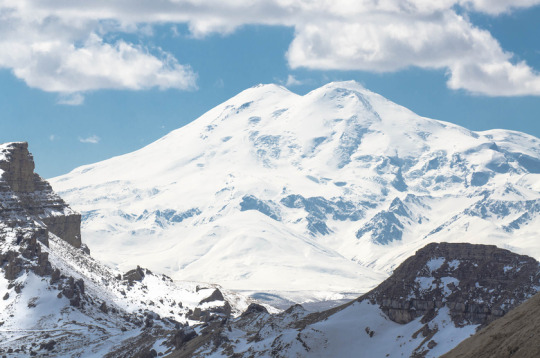
View On WordPress
0 notes
Photo
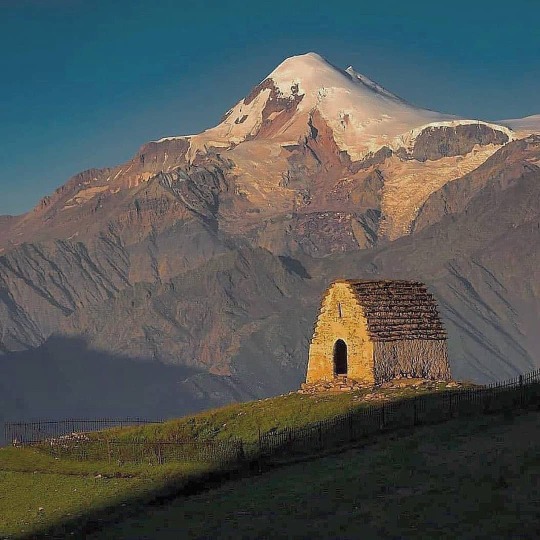
@ingush.heritage • Beshloam (Mount Kazbek), was known as the home of the tempered goddess of blizzards Furki, whom is also known Dardza-nanalg (which literally means mother of blizzards). She is one of many prominent goddesses of the Ingush pantheon. She is considered the wife to the thunder god Sela, and resides with him on Beshloam. One of Furkis powers involve creating invincible boundaries, and those who cross them are thrown off the steep cliffs of Beshloam. Her home is always illuminated and warm by the hearth of her home, and food is always renewed. On the orders of her husband Sela, Dardza-nanalg guards the imprisoned Kurkho/Pkharmat (Ingush version of Prometheus) to ensure his eternal imprisonment. Pagan Ingush would set up a special altar for her, known as “Daba”. Mountain goats and their horns would be sacrificed and put on heaps for the goddess. On a summer day, Ingush would celebrate the goddess with good food, music and dancing. • Бешлоам был известен как дом закаленной богини метели Фурки, которую также называют Дардца-нана (буквально означает мать метели). Она - одна из многих выдающихся богинь ингушской мифологии. Она жена бога грома Селы и живет с ним на Бешлоаме. Фурки тоже создает непреодолимые границы, и те, кто их пересекает, сбрасываются с крутых обрывов Бешлоама. Ее дом всегда освещен теплом домашнего очага, а еда всегда обновляется. По приказу мужа Селы, Дардца-нана охраняет заключенного Куркхо/Пхармата (Ингушский вариант Прометея). Ингуши-язычники поставили для нее особый алтарь, иначе известный как «Даба». Горных козлов и их рогов приносили в жертву богине. В летний день Ингуши чествовали свою богиню вкусной едой, музыкой и танцами. - #историяингушетия #ингушетия #ретро #history #caucasus #westasia #middleeast #ancientgreece #ancientrome #ingushetia #ingush #kabardin #balkaria #cherkessia #историяингушей #chokha #georgia #sakartvelo #russia #asia #europe #music #culture #anthropology #instagram #IngushRenaissance #ИнгушскоеВозрождение https://www.instagram.com/p/CLuJBylstoU/?igshid=bspljo75c953
#историяингушетия#ингушетия#ретро#history#caucasus#westasia#middleeast#ancientgreece#ancientrome#ingushetia#ingush#kabardin#balkaria#cherkessia#историяингушей#chokha#georgia#sakartvelo#russia#asia#europe#music#culture#anthropology#instagram#ingushrenaissance#ингушскоевозрождение
1 note
·
View note
Photo


Kabardin Horse
Olesya Nickolaeva Horse Photography
76 notes
·
View notes
Link
#collectible#100 years and older#russian postcard#antique postcard#Russian antiques#Russian rarity#Caucasus#types of men#types of caucasus#Weapons#HORSE#eBay#Kabardin Man#Tsarist Russia#1909s
0 notes
Photo
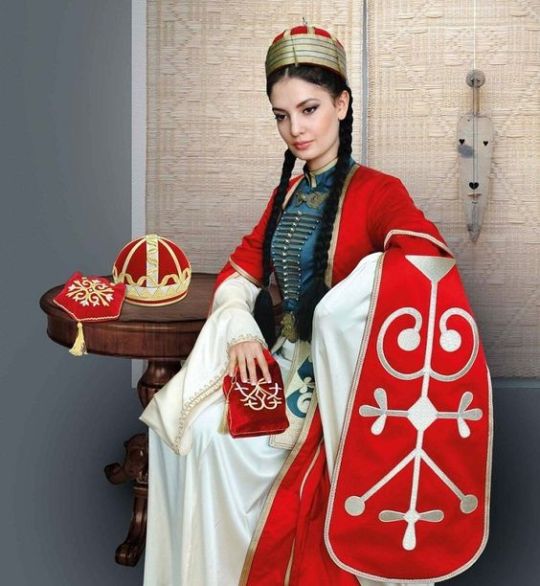
Ilona Zhilova, Miss Russian Radio 2004, from the Kabardino-Balcarian region. She is Kabardian.
The Kabardino-Balkarian Republic (Russian: Кабарди́но-Балка́рская Респу́блика, Kabardino-Balkarskaya Respublika; Kabardian: Къэбэрдей-Балъкъэр Республикэ, Ķêbêrdej-Baĺķêr Respublikê; Karachay-Balkar: Къабарты-Малкъар Республика, Qabartı-Malqar Respublika) or Kabardino-Balkaria (Russian: Кабарди́но-Балка́рия, Kabardino-Balkariya), is a federal subject of Russia (a republic) located in the North Caucasus. As of the 2010 Census, its population was 859,939 on 12,500 square km. Its capital is Nalchik. The area contains the highest mountain in Europe, Mount Elbrus, at 5,642 m. Mount Elbrus has 22 glaciers that feed three rivers — Baksan, Malka and Kuban. The mountain is covered with snow year-round.
Kabardino-Balkaria includes two major ethnic communities, the Kabardins (Circassians), who speak a North-West Caucasian language, and the Balkars who speak a Turkic language. Kabardins make up the bulk of the republic's population, followed by Russians and Balkars. Other groups include Ossetians, Turks, Ukrainians, Armenians, Koreans, Chechens.
The Kabardians (Highland Adyghe: Къэбэрдей адыгэхэр; Lowland Adyghe: Къэбэртай адыгэхэр; Russian: Кабардинцы), or Kabardinians, are the largest of the twelve Adyghe (Circassian) tribes (sub-ethnic groups). They are also commonly known by the plural terms Kabardin, Kebertei, or Kabarday. Along with the Besleney tribe, they speak a distinctive dialect of the Adyghe language. Historically the Kabardians lived in Kabardia, a region of the north Caucasus. In modern times the Kabardians live mostly in the Russian republic of Kabardino-Balkaria, which partly corresponds to the historic region.
164 notes
·
View notes
Text
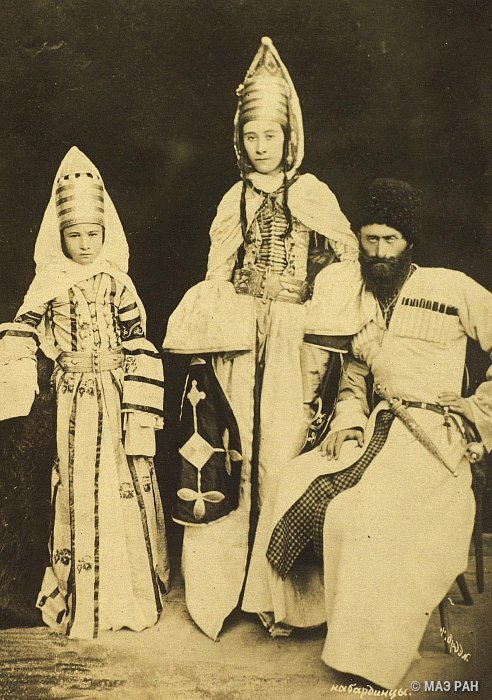
Noble Kabardians. 1890s
Знатные Кабардинцы. 1890s
From Kunstkamera archive.
Photographer A. Engel. (А.Энгель)
#Adyghe#Адыги#Kabardino-Balkaria#Кабардино-Балкария#Kabardin#Кабардинцы#non-russian#indigenous russia#indigenous russian#caucasian#Adyghe culture#Культура Адыги
14 notes
·
View notes
Text
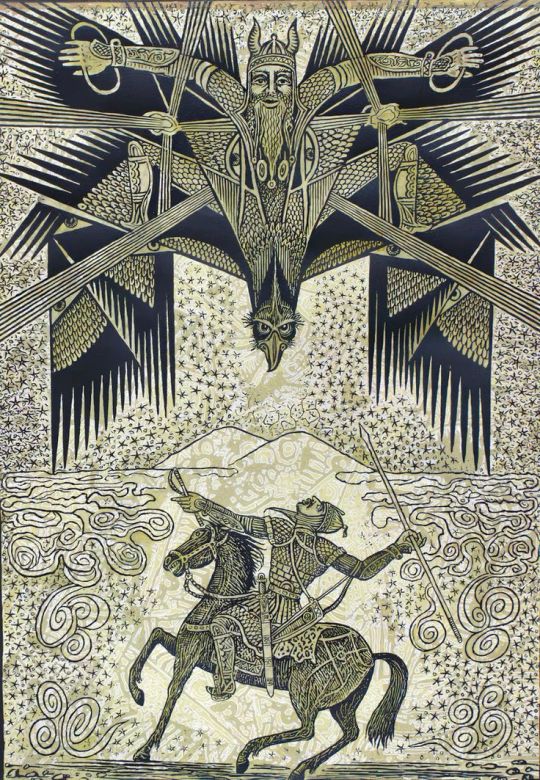
“Bataraz and Pako” by Kabardian artist Zaurbek Bgazhnokov, 2020-2021. From the Nart sagas
Source: https://pinterest.com/pin/636766834842897946/
#illustration#kabardines#kabarda#kabardino balkaria#caucasus#russia#northwest caucasian#2020s#circassians
3 notes
·
View notes
Note
Do you have any favorite breeds of livestock? Love your blog btw!
ah that's kind, thank you!
I don't have real favourite breeds for livestock, now that I think about it, mostly bc ag engineering messes with my capability of having livestock 'faves' since every operation has other needs, thus needs different breeds that are fit for the climate, the vegetatione etc.
but lemme see...
Generally I have a soft spot for pretty much every fat tailed sheep breed, the breed Red Karaman if I had to pick one (turkish breed). Goats get side eyed. I have and hopefully never shall have a favourite goat breed bc I can see myself getting way too invested.
For cattle I'd say Gelbvieh, which is a german dual purpose breed (used to be triple purpose even!)
With poultry it's just about any heritage breed tbh, just anything that's far away from common modern messes. I'm not a huge poultry person, that's all, so I can see myself not caring much for individual breeds as long as they're healthy and good all-rounders (dual purpose etc) and fit for local circumstances.
Never thought much about pigs but I guess I like Bentheimer Landschweine? They're funky and awake this feeling of 'genuine rural germany' whenever I see them.
When it comes to horses, DEFINITELY Noriker and Kabardin (and several more tbh but these two are absolute Heart Eyes Material™)
#thanks for the ask!#anon#agricultural engineering#i was wondering if i should mention meat rabbits too but i know many are uncomfortable with the concept of meat rabbits
3 notes
·
View notes
Photo
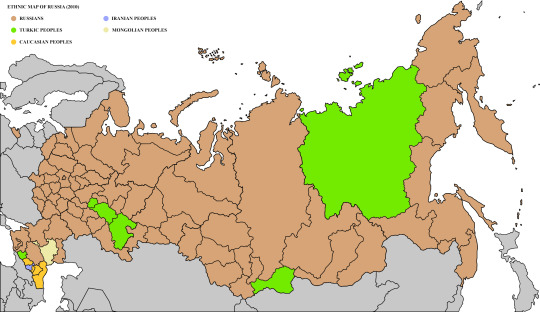
Map of Ethnic Majorities in Russia’s Federal Subjects
Aetherastra:
By Subject that have a non-Russian Majority:
Karachay-Cherkessia: Karachay(Turkic) Majority, with significant Cherkess/Circassian(Northwest Caucasian) minority
Kabardino-Balkaria- Kabardin(Circassian/Northwest Caucasian) majority, with significant Balkar(Turkic) Minority
North Ossetia-Alania- Ossetian(Iranian) Majority
Ingushetia - Ingush(Northeast Caucasian) Majority
Chechnya - Chechen(Northeast Caucasian) Majority
Dagestan- No outright majority, various Northeast Caucasian peoples together make up majority
Kalmykia- Kalmyk(Mongolian) Majority
Tatarstan- Tatar(Turkic) Majority
Chuvashia- Chuvash(Turkic) Majority
Bashkorstan- No outright majority, Tatars, Chuvash, and Bashkors(Turkic) together make up a majority.
Sakha: Yakut(Turkic) majority
Tuva: Tuvan(Turkic) majority
A Guide to Russia’s Federal Subjects is here
112 notes
·
View notes
Photo
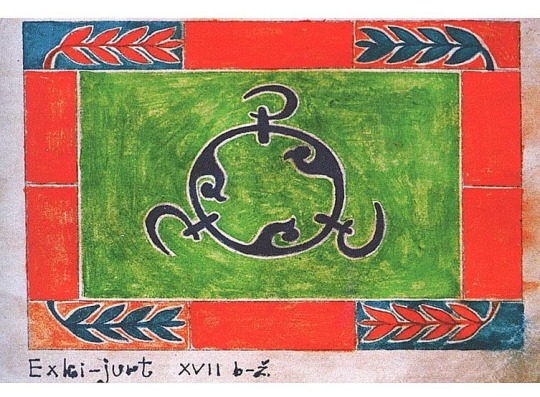
@ingush.heritage • Ornamental Ingush rugs from the 17th century. • Traditional Ingush ornamental rugs from the 17th century. These have been immortalized in a journal, and give us an insight into what families made them, where they were found and what century they’re from. Each elaborate design have their own meaning, and such wool rugs were often put on the floor or hanged on the walls for different purposes or occasions. Photos are retrieved from @ornamika_official, which worked with the Ingush historical community @dzurdzuki06. • Традиционные Ингушские орнаментальные ковры XVII века. Они были увековечены в журнале и дают нам представление о том, из каких семей они созданы, где они были найдены и из какого они века. Каждый сложный дизайн имеет свое значение, и такие шерстяные коврики часто кладут на пол или вешают на стены для разных целей или случаев. Фотографии взяты с сайта @ornamika_official, который работал с Ингушским сообществом: @dzurdzuki06. —— #историяингушетия #ингушетия #ретро #history #caucasus #westasia #middleeast #ancientgreece #ancientrome #ingushetia #ingush #kabardin #balkaria #cherkessia #историяингушей #chokha #georgia #sakartvelo #russia #asia #europe #music #culture #anthropology #instagram #IngushRenaissance #ИнгушскоеВозрождение https://www.instagram.com/p/CLuI2jKsShL/?igshid=11kbrb5qxrbxb
#историяингушетия#ингушетия#ретро#history#caucasus#westasia#middleeast#ancientgreece#ancientrome#ingushetia#ingush#kabardin#balkaria#cherkessia#историяингушей#chokha#georgia#sakartvelo#russia#asia#europe#music#culture#anthropology#instagram#ingushrenaissance#ингушскоевозрождение
1 note
·
View note
Photo

#repost @buyukturkailesi #turkmen #turk #kirgiz #uzbek #kazak #azeri #oguz #oghuz #tengri #proudtobeturkmen #unity #buyukturkailesi #buyukturkailesi #Büyük #Türk #Ailesi #Büyük Türk Ailesi #Türkiye #Azerbaycan #Türkmenistan #Özbekistan #Kazakistan #Kırgızistan #Kalmikya #Altay #güneyazerbaycan #Yakutya #Çuvasistan #Baskırdıstan #Hakasya #Tuva #Kirim #Tataristan #Karaçay #Karakalpak #Kabardin #Gagauziya #Turan #Tengri #Tengricilik #Tengrizm #world #history #feelingproud #igdir #gokturkmen #patriotism (at Some of my favorite pictures)
#hakasya#türk#yakutya#çuvasistan#kabardin#uzbek#gokturkmen#turan#patriotism#turk#repost#azeri#özbekistan#kırgızistan#ailesi#kazak#igdir#unity#kirim#gagauziya#karaçay#türkiye#oguz#kalmikya#altay#kirgiz#tengri#büyük#azerbaycan#baskırdıstan
0 notes